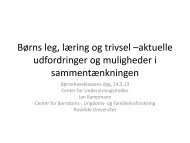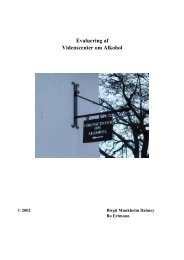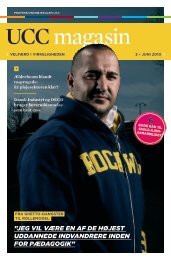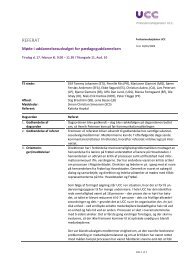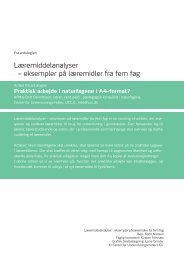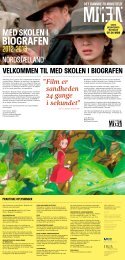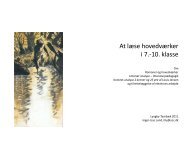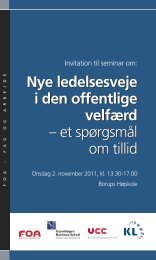AGORA - tidsskrift for forskning, udvikling og idéudveksling i ...
AGORA - tidsskrift for forskning, udvikling og idéudveksling i ...
AGORA - tidsskrift for forskning, udvikling og idéudveksling i ...
Create successful ePaper yourself
Turn your PDF publications into a flip-book with our unique Google optimized e-Paper software.
<strong>AGORA</strong> - <strong>tidsskrift</strong> <strong>for</strong> <strong>for</strong>skning,<br />
<strong>udvikling</strong> <strong>og</strong> <strong>idéudveksling</strong> i professioner<br />
Embodiment & learning<br />
By Professor Reinhard Stelter<br />
Institute of Exercise and Sport Sciences<br />
University of Copenhagen<br />
Email: rstelter@ifi.ku.dk<br />
There is a myth that learning processes are initiated in the brain. For sure, nobody wants to deny the<br />
role of cerebral activity in the interaction of a person with the environment. But is this approach really<br />
the best way to start? Do we really understand the relationship of man in his world while reducing<br />
this relationship to cerebral processes? I doubt it. In this article, embodiment is the starting point <strong>for</strong><br />
an alternative approach. The intention is to turn things from the head on to the feet, or better, from the<br />
head into the lived body. The aim is to highlight the participation of our lived body in the unfolding of<br />
experience and learning. In that sense, the concept of embodiment leads to an understanding where we<br />
can speak of body-anchored and experience-based learning.<br />
The article will focus on the following issues:<br />
• Premises of body-anchored and experience-based learning<br />
• Body-anchored and experience-based learning as being a part of a community of practice<br />
• Ideas on how to put a body-anchored and experience-based approach into practice<br />
The lived body as the basis <strong>for</strong> experience and perception<br />
In this first section, some theoretical reflections on an experience-based understanding of the body will be<br />
highlighted. The subsequent presentation is the basis, firstly, <strong>for</strong> a thorough insight into the first-person<br />
perspective (Varela & Shear, 1999) and, secondly, <strong>for</strong> an applied perspective presented later in this article.<br />
From a phenomenol<strong>og</strong>ical standpoint, Merleau-Ponty (1962) defines the body as a mediator<br />
to the world and “our anchor in the world” (p. 144). He writes: “External perception and the perception<br />
of one’s own body vary in conjunction because they are the two facets of one and the same act” (ibid., p.<br />
205). And he continues: “Every external perception is immediately synonymous with a certain perception<br />
of my body, just as every perception of my body is made explicit in the language of external perception”<br />
(ibid., p. 206).<br />
This understanding makes it possible to overcome the dualism between mind and nature and<br />
between the inner and outer world. However, Waldenfels (1985, 163) notes that duality is still a part of<br />
our life concept: I have my body and at the same time I am my body. The understanding of the concept of<br />
the human body is – as Madison (1981) states – a strange “mixture of being-in-itself and being-<strong>for</strong>-itself”<br />
(p. 24). Merleau-Ponty (1962) is conscious of this ambiguity or rather, circularity, when stating:<br />
“The union of soul and body is not an amalgamation between two mutually external terms,<br />
subject and object, brought up by arbitrary decree. It is enacted at every instant in the movement<br />
of existence.” (pp. 88-89)<br />
It is due to Sheets-Johnstone (1999) that experience and perception are highlighted as embodied in<br />
movement. Movement seems to be the concept where the body as an object and the body as a subject<br />
appear as being integrated. In that sense, we could argue that Sheets-Johnstone (1999) goes a step further<br />
in her phenomenol<strong>og</strong>ical thinking than Merleau-Ponty, when she aims to “elucidate both the experience<br />
and foundations of thinking in movement” (p. 483). As an essential <strong>for</strong> her approach she speaks about a<br />
“non-separation of thinking and doing” (p. 485). She explicates her understanding by referring to the<br />
experience and action of a dancer who – while improvising – is thinking in movement. She writes:<br />
www.cvustork.dk/agora/ 7





